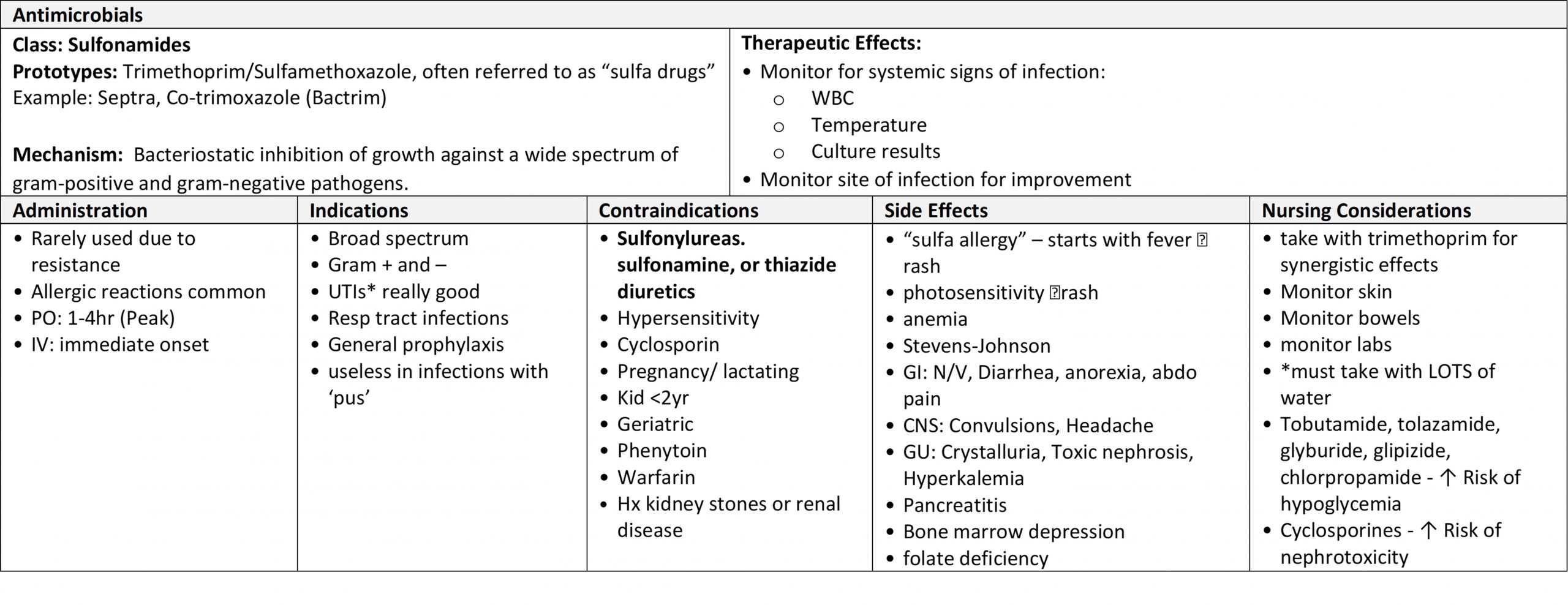Antimicrobials
3.10 Sulfonamides
Open Resources for Nursing (Open RN)
Sulfonamides are one of the oldest broad-spectrum antimicrobial agents that work by competitively inhibiting bacterial metabolic enzymes needed for bacterial function.
Indications for Use: Sulfonamides are used to treat urinary tract infections, otitis media, acute exacerbations of chronic bronchitis, and travelers’ diarrhea.
Mechanism of Action: This mechanism of action provides bacteriostatic inhibition of growth against a wide spectrum of gram-positive and gram-negative pathogens.
Nursing Considerations Across the Lifespan: Sulfonamides are safe for use in pregnancy and with paediatric clients. Dosing should be altered for any client with renal insufficiency.
Specific Administration Considerations: Allergic reactions to sulfonamide medications are common and, therefore, clients should be monitored carefully for adverse effects including delayed hypersensitivity reactions. Sulfonamide medications increase the risk of crystalluria that can cause kidney stones or decreased kidney function; therefore, clients should increase their water intake while taking these medications.[1]
Client Teaching & Education: The client should receive education to complete the full prescribed dose of medications and take measures to not skip doses. If a dose is missed, the client should take the missed dose as soon as possible unless it is near the next dosing time. The medication can cause increased photosensitivity, and clients should be educated to use sunscreen and protective clothing with sun exposure. The client should also report any rash, sore throat, fever, or mouth sores that might occur. Unusual bleeding or bruising should also be reported to the provider. If clients are receiving prolonged therapy, they may require platelet count monitoring.[2]
Now let’s take a closer look at the medication card for trimethoprim-sulfamethoxazole in Table 3.9.[3] Because information about medication is constantly changing, nurses should always consult evidence-based resources to review current recommendations before administering specific medication.
Table 3.9 Sulfonamides Medication Card
Class: Sulfonamides (prototype: trimethoprim – sulfamethoxazole)

Clinical Reasoning and Decision-Making Activity 3.9a
Using the above information, consider the following clinical scenario question:
A nurse is caring for an elderly diabetic client who has been prescribed trimethoprim-sulfamethoxazole for a urinary tract infection. What nursing interventions will be implemented prior to medication administration?
Note: Answers to the Critical Thinking activities can be found in the “Answer Key” sections at the end of the book.
Media Attributions
- sulfonamides
- This work is a derivative of Microbiology by OpenStax licensed under CC BY 4.0. Access for free at https://openstax.org/books/microbiology/pages/1-introduction ↵
- uCentral from Unbound Medicine. https://www.unboundmedicine.com/ucentral ↵
- Daily Med, https://dailymed.nlm.nih.gov/dailymed/index.cfm, used for hyperlinked medications in this module. Retrieved June 27, 2019 ↵

